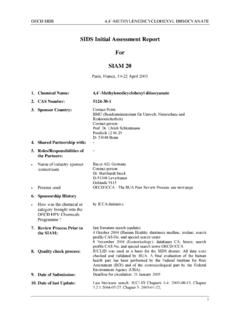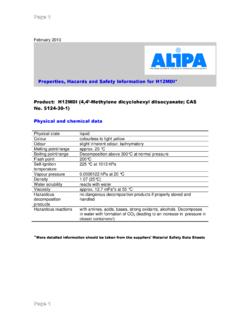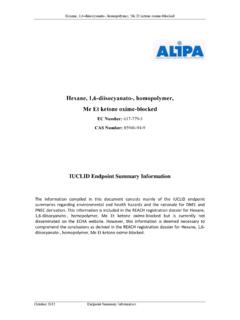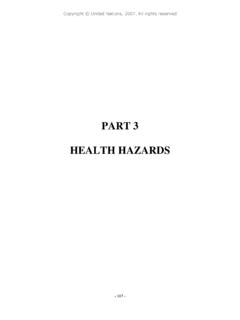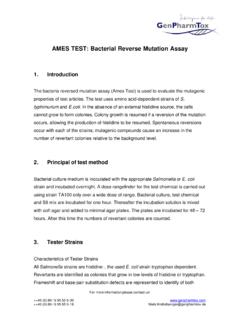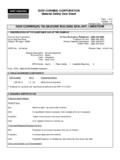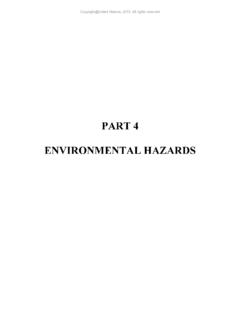Transcription of SIDS Initial Assessment Report For SIAM 23 - ALIPA
1 OECD sids 3-ISOCYANATOMETHYL-3,5,5-TRIMETHYLCYCLOH EXYL ISOCYANATE 1 sids Initial Assessment Report For siam 23 Jeju (Korea), October 17-20, 2006 1. Chemical Name: 3-Isocyanatomethyl-3,5,5-trimethylcycloh exyl isocyanate 2. CAS Number: 4098-71-9 3. Sponsor Country: GermanyContact Point: BMU (Bundesministerium f r Umwelt, Naturschutz und Reaktorsicherheit) Contact person: Prof. Dr. Ulrich Schlottmann Postfach 12 06 29 D-53048 Bonn 4. Shared Partnership with: Bayer MaterialScience AG: Dr. J. Br ck (Germany) Bayer MaterialScience LLC: Robin Ruppel-Kerr (USA) Degussa North America: Alex Bell (USA) Rhodia Operations: Dr. Bernard Hendrickx (France) 5. Roles/Responsibilities of the Partners: Name of industry sponsor /consortium Degussa AG, Germany Contact person: Dr. R. Ebert Bennigsenplatz 1 D-40474 Duesseldorf Process used see next page 6. Sponsorship History How was the chemical or category brought into the OECD HPV Chemicals Program?
2 By ICCA initiative 7. Review Process Prior to the siam : last literature search (update): 26 April 2006 (Human Health): databases Biosis, Embase, Medline, Toxline, Scisearch; search profile CAS-No. and special search terms 31 March 2006 (Ecotoxicology): databases Beilstein, Chemlist and Chemical Abstracts; search profile CAS-No. and special search terms 8. Quality check process: As basis for the sids -Dossier the IUCLID was used. All data have been checked and validated by BUA. A final evaluation of the human health part has been performed by the Federal Institute for Risk Assessment (BfR) and of the ecotoxicological part by the Federal Environment Agency (UBA). 9. Date of Submission: Deadline for circulation: 13 September 2006 10. Date of last Update: - OECD sids 3-ISOCYANATOMETHYL-3,5,5-TRIMETHYLCYCLOH EXYL ISOCYANATE 2 11. Comments: - OECD/ICCA - The BUA* Peer Review Process Qualified BUA personnel (toxicologists, ecotoxicologists) perform a quality control on the full sids dossier submitted by industry.
3 This quality control process follows internal BUA guidelines/instructions for the OECD/ICCA peer review process and includes: - a full (or update) literature search to verify completeness of data provided by industry in the IUCLID/HEDSET - Review of data and Assessment of the quality of data - Review of data evaluation - Check of adequacy of selection process for key studies for OECD endpoints, and, where relevant, for non-OECD endpoints by checking original reports/publications - Review of key study description according robust summaries requirements; completeness and correctness is checked against original reports/publications (if original reports are missing: reliability (4), reliability not assignable) - Review of validity of structure-activity relationships - Review of full sids dossier (including SIAR, SIAP and proposal for conclusion and recommendation for further work) In case of data gaps, review of testing plan or rationale for not test * BUA (GDCh-Beratergremium fuer Altstoffe): Advisory Committee on Existing Chemicals of the Association of German Chemists (GDCh) OECD sids 3-ISOCYANATOMETHYL-3,5,5-TRIMETHYLCYCLOH EXYL ISOCYANATE 3 sids Initial Assessment PROFILE CAS No.
4 4098-71-9 Chemical Name 3-Isocyanatomethyl-3,5,5-trimethylcycloh exyl isocyanate Structural Formula OCNNCOH3 CCH3CH2CH3 SUMMARY CONCLUSIONS OF THE SIAR Human Health The only information available on the toxicokinetics of 3-isocyanatomethyl-3,5,5-trimethylcycloh exyl isocyanate results from a test chamber exposure of three volunteers to concentrations of , and mg /m3 for 2 hours at day 1, 3, and 5, respectively. After hydrolysis of blood and urine samples the corresponding amine, 3-aminomethyl-3,5,5-trimethylcyclohexyla mine, was detected in urine but not in plasma. The average urinary excretion was 27 % and urinary elimination half-time was hours. No 3-aminomethyl-3,5,5-trimethylcyclohexyla mine was observed in samples without hydrolysis from exposed persons. Assessment of the acute inhalation toxicity data indicates that effects caused by exposure to respirable aerosols of 3-isocyanatomethyl-3,5,5-trimethylcycloh exyl isocyanate were confined predominantly to the respiratory tract.
5 Clinical signs (serous nasal discharge, bradypnea, stridor) indicated respiratory distress. There are two studies according to OECD TG 403 with LC50-values (4 h, rat) of approximately 40 mg/m3 and 31 mg/m3, respectively. Special investigations with male rats revealed airway rather than pulmonary irritation, which became evident after exposure of a concentration causing some lethality (25 mg/m3, 1 x 6 h). The dermal LD50 determined in compliance with OECD TG 402 was > 7000 mg/kg bw for rats. Non-specific, transient signs of intoxication (sedation, ataxia) and obvious skin irritation at the application site were reported. The available studies revealed a low oral toxicity with LD50-values (rat) of 4814 - 5490 mg/kg bw. Toxic symptoms after oral administration included decreased activity, piloerection, and diarrhea. In two studies performed according to OECD TG 404, 3-isocyanatomethyl-3,5,5-trimethylcycloh exyl isocyanate was found to be corrosive to the rabbit skin.
6 Strong irritation was observed in rabbit eyes when tested according to OECD TG 405. The toxicity studies indicate that 3-isocyanatomethyl-3,5,5-trimethylcycloh exyl isocyanate vapor causes irritation of the upper respiratory tract. In a study with volunteers, a perception threshold for irritation of mg/m3 was determined for short-term (1-5 minutes) exposure to 3-isocyanatomethyl-3,5,5-trimethylcycloh exyl isocyanate. 3-Isocyanatomethyl-3,5,5-trimethylcycloh exyl isocyanate was found to be skin sensitizing in the Buehler test according to or equivalent to the EU Directive, in the guinea pig maximization test comparable or according to OECD TG 406, in the mouse ear swelling test, and in the open epicutaneous test. Skin sensitization was also observed in humans. One case Report describes respiratory hypersensitivity after occupational exposure to 3-isocyanatomethyl-3,5,5-trimethylcycloh exyl isocyanate.
7 No validated animal model is available to assess the potential for respiratory sensitization or asthma in humans, and one animal study did not show respiratory tract sensitization when exposed by inhalation (challenge) following intradermal induction. However, due to the well known reactivity of diisocyanates, respiratory sensitization is likely to occur. No repeated-dose toxicity tests are available for the oral and dermal route of exposure. A subacute inhalation study ( , , and mg/m3; 6 hours/day, 5 days/week, 4 weeks; OECD TG 412) with male and female Wistar rats indicates the respiratory tract to be the target organ. Clinical signs of respiratory tract irritation (nostrils: red encrustations, stridor, nasal discharge, breathing sounds, hypothermia) are restricted to the high concentration rats. OECD sids 3-ISOCYANATOMETHYL-3,5,5-TRIMETHYLCYCLOH EXYL ISOCYANATE 4 The LOAEL is mg/m3 (histopathological changes in nasal cavity and larynx).
8 At mg/m3 also the pharynx, trachea, and lungs are affected but the lesions are reversible within the four weeks of recovery with regard to the lung and trachea. However, lesions in the nasal cavity, the pharynx, and the larynx still occurred in some animals with minimal or slight degree. The most relevant systemic effects were a slight decrease in body weight gain in the high dose group and an increased leukocyte count in the peripheral blood in mid and high dose groups. The NOAEL is mg/m3. 3-Isocyanatomethyl-3,5,5-trimethylcycloh exyl isocyanate was not genotoxic in bacterial systems in vitro (Ames test). Neither Salmonella typhimurium TA 102 nor Escherichia coli WP2 were tested in these Ames tests, however, this is an acceptable restriction because it can be assumed that 3-isocyanatomethyl-3,5,5-trimethylcycloh exyl isocyanate has no oxidizing or cross-linking potential which may be detected by S.
9 Typhimurium TA 102 or E. coli WP2. In a chromosomal aberrations test performed on Chinese hamster ovary cells according to OECD TG 473, results were positive both with and without metabolic activation. In vivo, no mutagenic activity was detectable in a micronucleus assay on mice according to OECD TG 474 using the inhalation route of administration. However, as the micronucleus test only covers systemic genotoxic effects and given the well known high local reactivity of the substance local genotoxic effects cannot be excluded. No studies have been performed to explicitly address the question of reproductive effects in animals caused by 3-isocyanatomethyl-3,5,5-trimethylcycloh exyl isocyanate. Histopathological results of a subacute 28-day inhalation study in rats according to OECD TG 412 showed no effects regarding the reproductive organs in concentrations up to mg/m3.
10 Testes and ovary weights were also not affected. Taking into account the knowledge about the mode of action of 3-isocyanatomethyl-3,5,5-trimethylcycloh exyl isocyanate (local effects at sites of immediate contact clearly predominant), the lack of effect on the reproductive organs at mg/m3, and as the NOAEL for repeated dose toxicity is set at mg/m3 it seems quite unlikely that this substance might have critical effects on testis in this low dose range. In a nose-only inhalation study performed in accordance with OECD TG 414, 3-isocyanatomethyl-3,5,5-trimethylcycloh exyl isocyanate had no adverse effects on the development of rats up to and including a dose level of mg/m3. A dose of mg/m3 was maternally toxic as evidenced by effects on respiratory tract and fur as well as decreased feed intake and impaired body weight gain. All signs of developmental toxicity observed at the mg/m3 exposure level, reduced fetal weights, delayed descensus testis, and slightly retarded ossification, were indicative of delayed fetal development and were only seen in the presence of maternal toxicity and thus considered secondary effects.
